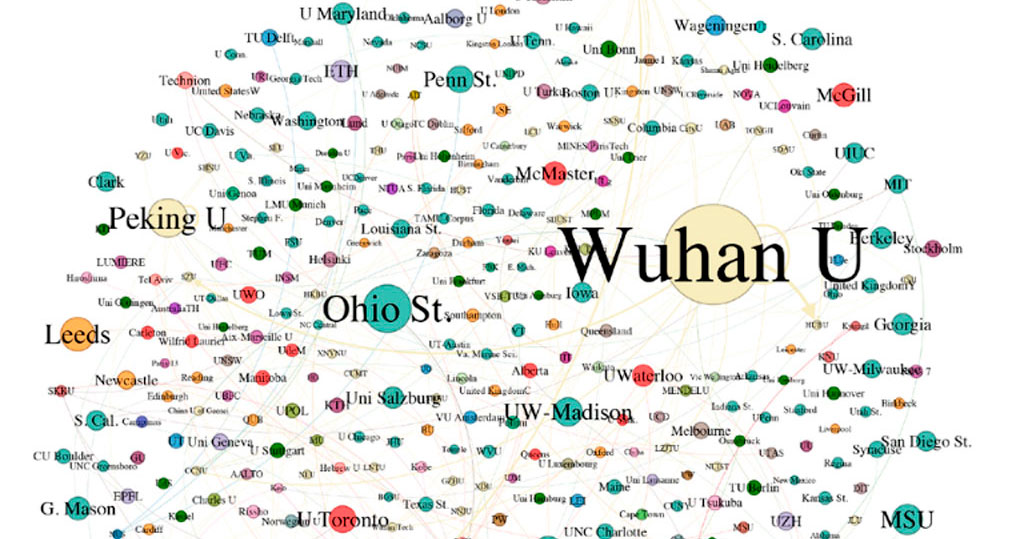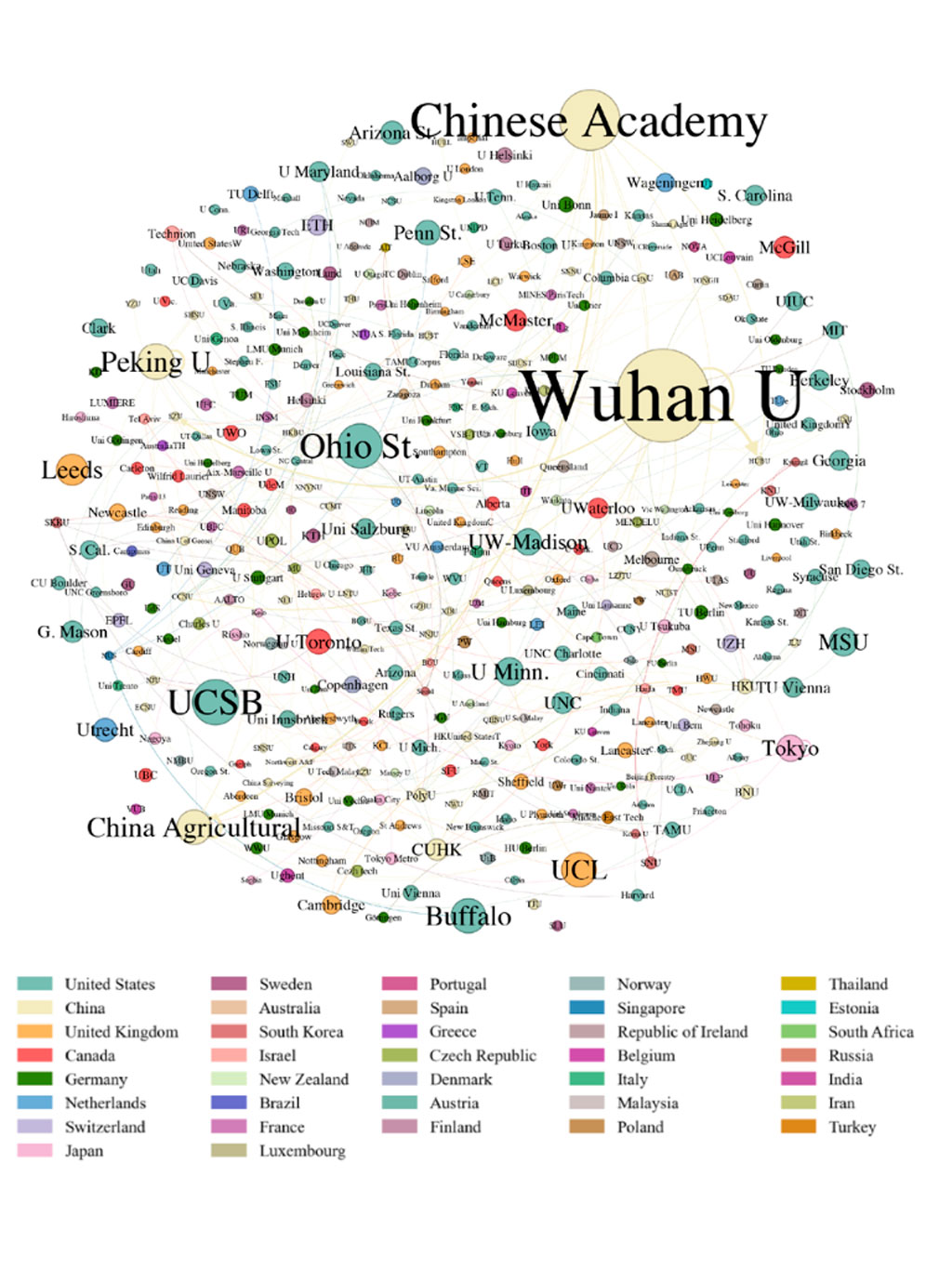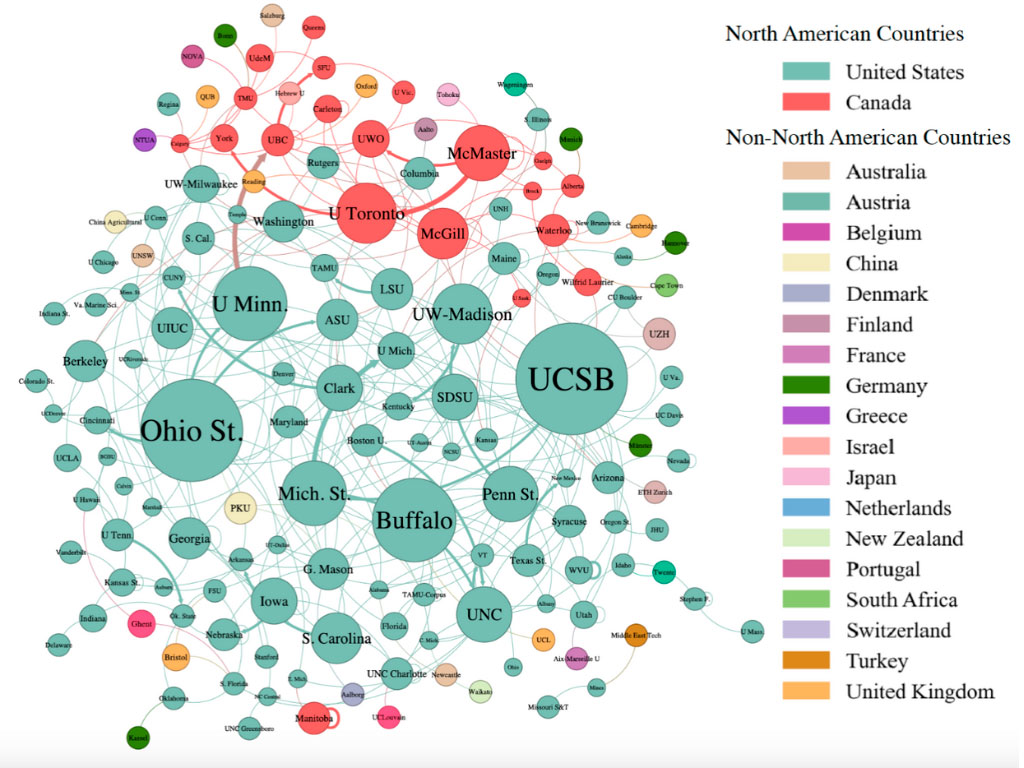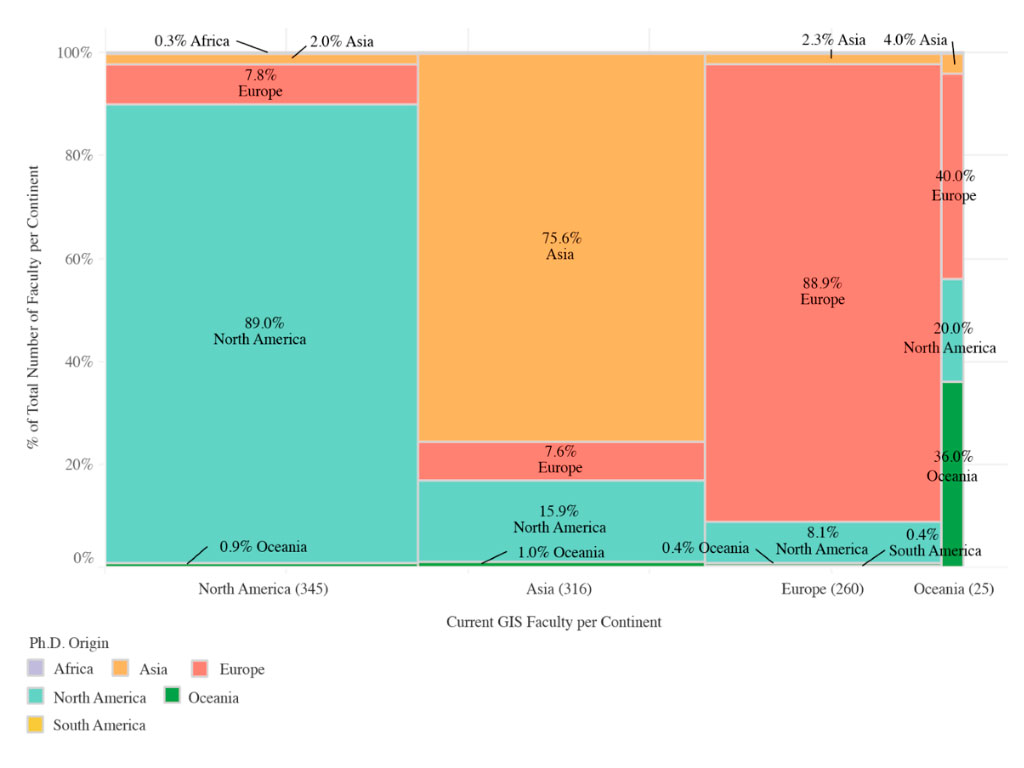Where are GIScience Faculty Hired From?

Analyzing Faculty Mobility and Research Themes Through Hiring Networks
The following Perspective is drawn from a paper currently under review at Cartography and Geographic Information Science journal. This research was supported by the CaGIS Rising Award and the GISphere project, which summarizes more than 400 GIS programs and faculty information globally.
By Yanbing Chen, University of Wisconsin, Madison and Yuhao Kang, University of Texas, Austin
Academia is profoundly shaped by the dynamics of faculty hiring networks, acting as a pathway for knowledge dissemination and collaborative research formation in higher education. With rapid technological advances and a surging demand for spatial analysis, GIScience is transforming research and industry alike, underscoring the need to examine how hiring practices influence academic networks and research trajectories. This study addresses the gap by analyzing data provided via the GISphere project (GISphere Institution Guide, 2023) on 946 GIScience faculty members from 384 universities across 27 countries. We employ network and word cloud analyses to demonstrate the connections between PhD-granting institutions and faculty affiliations, revealing global placement patterns, diversity in hiring trends, and the thematic evolution in GIScience research interests between year 1990 and 2024. These findings contribute to the broader discourse on faculty hiring (in)equities and provide insight into the formation of research clusters within the GIScience community.
The network analysis of GIScience faculty placements reveals that hiring is predominantly concentrated within the Global North. North America, Asia, and Europe collectively account for 92% of GIS faculty positions, with the United States (28.54%), China (26.74%), and the United Kingdom (8.35%) leading in faculty placements. The analysis shows that certain institutions play a dominant role in the GIS hiring network. For example, Wuhan University, Chinese Academy of Sciences, University of California Santa Barbara, The Ohio State University, and Peking University are responsible for 15.43% of all global GIS faculty placements (Figure 1). While faculty hiring in other fields, such as computer science and economics, follows a clear prestige-driven hierarchy (Clauset et al., 2015; Wapman et al., 2022), the GIS hiring network appears more decentralized, with a wider distribution of contributing institutions. However, this relative decentralization does not eliminate regional inequalities. The network structure reveals localized recruitment patterns within continents. For instance, North American GIS faculty often originate from U.S. or Canadian PhD programs, while European institutions tend to hire graduates from within Europe. This regional clustering reflects the limited cross-continental mobility of GIS faculty, likely influenced by geographic proximity, immigration policies, and reduced recruitment costs for regional candidates.

The diversity index refers to the proportion of faculty originating from a particular region relative to the total affiliated faculty within that same region. It examines regional disparities in hiring patterns at the continental, country, and institutional levels. At the continental level, North America has the lowest diversity index, with only 11.01% of GIS faculty holding PhDs from outside the continent (Figure 2). Asia (24.37%) and Oceania (64.00%) show higher cross-continental hiring, though often from neighboring regions or countries with historical ties. Europe reports 11.15% diversity overall, with nine countries having 0% diversity, as all GIS faculty obtained PhDs within Europe. The country-level diversity index highlights varying patterns of domestic retention. For example, in the United States, 87.70% of faculty obtained their PhD domestically, while China exhibits a similar pattern, with 79.45% of GIS faculty holding domestic PhDs. Conversely, Singapore and Thailand have the highest country-level diversity indices (100%), indicating reliance on external academic talent. At the institutional level, external recruitment is common. On average, 60.66% of GIS faculty at global universities were externally recruited. These trends suggest that while universities value external perspectives to promote intellectual diversity, internal recruitment practices persist in countries with smaller academic systems (Figure 3).


The findings of this study have important implications for GIScience education and hiring policies. The preference for internal recruitment at continental and country levels highlights the need to promote international mobility. Institutions should encourage greater international recruitment, particularly from underrepresented regions like Africa and South America, to diversify the pool of GIS scholars. The role of influential institutions in global GIS hiring also raises concerns about academic equity. While GIS faculty placement appears less hierarchical than in other fields, the concentration of placements within a small subset of universities highlights a potential inequity in access to faculty positions. Universities seeking to foster a more inclusive academic environment should consider promoting mobility pathways for PhD graduates from less influential institutions. In conclusion, hiring patterns and thematic shifts in GIScience highlight the importance of fostering a more inclusive, globalized GIS community, ensuring that ideas from across the world are equitably represented in GIS education and research.
References
Clauset, A., Samuel Arbesman, Daniel Larremore. (2015) Systematic inequality and hierarchy in faculty hiring networks. AAAS Science Advances, 12 Feb 2015, Vol 1, Issue 1. DOI: 10.1126/sciadv.1400005
Wapman, K.H., Sam Zhang, Aaron Clauset, Daniel B. Larremore. 2022. Quantifying hierarchy and dynamics in US faculty hiring and retention. Nature 610, pp. 120–127. Access https://www.nature.com/articles/s41586-022-05222-x
Perspectives is a column intended to give AAG members an opportunity to share ideas relevant to the practice of geography. If you have an idea for a Perspective, see our guidelines for more information.


